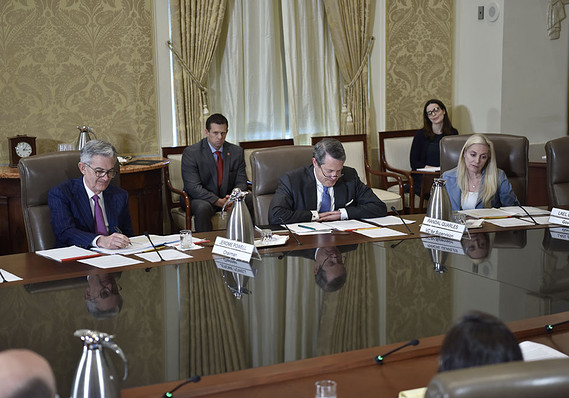 Federal Reserve
Federal Reserve
The Fed’s take: The U.S. economy expanded at “a modest pace overall” from April to mid-May, but growth was partly held in check by labor shortages and worries over tariffs on China, the Federal Reserve said.
The Fed’s periodic examination of the economy, known as the Beige Book, was a bit more upbeat compared to the previous report in April that described U.S. growth as “slight to moderate.”
One big caveat: The breakdown in trade talks with China that triggered a new round of tariffs occurred just a few days before the Fed survey was completed. The current Beige Book covers the period from April 9 to May 24.
What happened: The broader U.S. economy showed resilience in the spring despite increasing headwinds. Growth was steady and inflation remained subdued despite the lowest unemployment rate in 50 years and higher prices for some foreign goods.
Most key sectors grew, though there were some pockets of weakness.
“Signs of slowing activity and a more uncertain outlook” were found among certain manufacturers, the Fed noted, and “agricultural conditions remained weak overall.”
U.S. tariffs on China was one problem many companies cited. “Trade uncertainty has delayed business investment,” The Philadelphia Fed reported. “Tariffs remained a key concern for many manufacturers.”
Shortages of both high-skilled and even low-skilled labor is another hurdle.
Although “employment continued to increase nationwide,” the Fed said, hiring was “constrained by tight labor markets.”
Big picture: The Fed’s Beige Book suggests the economy was showing gradual improvement until the latest flareup in trade tensions with China. President Trump has since threatened to slap tariffs on Mexico unless it stops the flow of central American immigrants toward the U.S.
Other reports on the economy have been mixed. Manufacturers are growing more slowly, but the much larger service side of the economy is hanging in there.
The threat of escalating trade tensions, however, has been enough to force senior Fed officials to leave open the possibility that the central bank could cut interest rates soon.
Beige Book highlights: “Despite persistently tight labor markets, wage growth was subdued, as was inflation generally,” the New York Fed said.
“A number of businesses in New York state have noted ongoing challenges from the recent minimum wage increase; some reported that they are investing more in automation,” the New York Fed said.
“Farmers continued to be challenged by poor weather and low crop prices,” the Chicago Fed said.
Companies “noted many underqualified applicants” in their effort to fill open jobs, the Boston Fed said.
“Two contacts supplying Boeing said that the problems with the 737 MAX did not have a material effect on their business,” the Boston Fed said.
Read: ‘Whiff of U.S. recession’? It’s in the air again, but strong labor market the antidote
The Dow Jones Industrial Average DJIA, +0.68% and S&P 500 SPX, +0.64% rose in Wednesday trades, setting up a second straight gain after Federal Reserve Chairman Jerome Powell indicated an openness to a cut in U.S. interest rates.
Read: Fed’s Bullard says FOMC may have to cut rates soon due to trade wars, low inflation
The 10-year Treasury yield TMUBMUSD10Y, -0.61% slipped to 2.09%










Add Comment